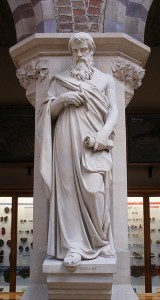Continuing my series on Aquinas; find the rest here.
Now, preliminaries settled, we dive into the deep end. Chapter 3 of the
Compendium Theologiae begins,
Regarding the unity of the divine essence, we must first believe that God exists. This is a truth clearly known by reason.
In dealing with truths known by revelation, Thomas proceeds in one of two ways. Some of these revealed truths can also be known by reason; and these he attempts to prove. Others can be known only by revelation; and then, Thomas’ task is to show that they are not contrary to reason. Here, at the beginning, there are many things we can know by reasoning from what we see around us, and one of them is the existence of God.
Christianity, as Judaism before it, sees God as one, as the almighty creator of all things. God isn’t like the gods of the Greeks and Romans, who (as the myths tell) came to be in the course of time, and who are basically immortal humans with super powers. Rather, scripture reveals God to be the source and creator of all that is. A “god” that owed his existence to some other could not be the God of Abraham, Isaac, and Jacob.
Thomas finds an echo of this in Aristotle’s notion of the First and Unmoved Mover—but before we go into that, we need to spend some time thinking about motion.
We observe that all things that move are moved by other things, the lower by the higher.
The word “move” in this passage is a much richer word than you might think. Thomas isn’t thinking just of physical motion from place to place (though he is thinking of that, too) but of all kinds of change: not just balls rolling, but apples ripening, children being born, animals dying, the world come into being.
The essential point here is that when something changes in some way, there is something that caused that change. And everything that comes into being has something that brought it into being.
Next, Thomas gives some examples that would have been familiar to his contemporaries, examples that are going to be a bit of problem for us:
The elements are moved by heavenly bodies; and among the elements themselves, the stronger moves the weaker; and even among the heavenly bodies, the lower are set in motion by the higher.
He’s saying that the things of the world around us are moved by the heavenly bodies, that is, the stars and planets. He seems to be endorsing a kind of astrology! To understand what’s going on here (and why it isn’t fatal) we need to understand two things: Thomas’ use of examples, and the nature of medieval astronomy.
Moderns often read passages like this one as Thomas giving evidence for his position, as a modern scientist or lawyer would. In these fields, you’re not proving propositions in an absolute and certain sense; instead, you’re merely trying to give evidence leading to a probable conclusion. We see this clearly in Newton and Einstein: Newton stated certain laws of physics that fit the evidence at hand, and were quite useful; but they were not the final word. Einstein discovered cases where they didn’t apply as Newton understood them, leading to a more general understanding. All conclusions of modern science are like this: our best understanding of the matter at hand, based on the evidence, until we discover something new that doesn’t fit.

That isn’t Thomas’ approach. He proceeds by philosophical demonstration, which is similar to the kind of mathematical proof most of us encountered in Geometry class. In a properly done philosophical demonstration, the conclusions are absolutely certain—always provided that the premises of the argument are true. We don’t see all of this philosophical machinery in the Compendium Theologiae, mind you, because it is an extreme concise summary. But it is all present in Thomas’ mind, and fleshed out in his other works.
Thus, his examples are not meant to be evidence, but illustrations, to help us understand what he’s on about. And so, when (as now) he bases an example on something of which we have a better understanding, that doesn’t invalidate his argument; at most, it invalidates his example.
To Be Continued!
____
photo credit: Arenamontanus via photopin cc








